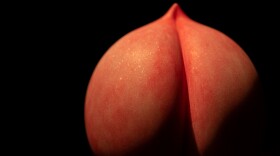Paul Bogard, the author of the paperback, The End of Night, went on a journey in search of something rare in America and Europe—true darkness. He wanted to have the jaw-dropping experience of looking up at the night sky to see uncountable stars and planets that we seldom see due to light pollution.
It's not easy to find true dark anymore; in fact, with each passing decade there are more lights than ever before, and some experts project that within fifty years we will no longer know the night sky at all.
If you think this is an exaggeration, and that you can see stars on a dark road in your rural town, Paul has convinced us, and so have the astronomers he consults, that light is bleeding great distances from city and town centers, harbors, highways, parking lots, factories, office parks, nuclear plants, street lights, home lights, and more. That bleeding light lessens the contrast and prevents us from seeing the star-filled sky that has astonished people as far back as recorded history goes. How can we have safety, and also protect the night sky?
Bogard's beautifully written story about his search for true dark and night sky, tells us the following things:
- One author refers to twilight as "that long blue moment." The nature writer Wendell Berry says, "To know the dark, go dark."
- We like to think that darkness falls, as though it were like snow, but as the earth turns its back to the sun darkness actually rises from the east to wash and flood over land and sea.
- Seen from satellites at night, our planet's continents burn as though on fire...night's natural darkness has always been invaluable for our health and the health of the natural world, and every living creature suffers from its loss. (Some studies show light pollution is linked to cancer.)
- Already, some two-thirds of Americans and Europeans no longer experience real night, true darkness, and what is seen because of it. Our galaxy has several hundred billion stars. Outside our galaxy exist innumerable other galaxies -- one recent estimate put the number at 500 billion. At some quick point the size of the universe becomes overwhelming, its distances and numbers bending our brains as we try to comprehend the incomprehensible -- that our night sky is but one tiny plot in a glowing garden too big to imagine.
- Painter Vincent van Gogh said, "It often seems to me that the night is much more alive and richly colored than the day." (You can see his iconic painting Starry Night at MOMA in New York. I have and it's worth doing.)
- Light pollution is caused by poorly designed or installed light fixtures and our using more light than we need, and all could be significantly and -- compared to other challenges we face -- easily remedied.
Paul Bogard recalls a night in Morocco where there was such darkness and the sky so exploded with stars, "I thought I'd stepped into a snowstorm."
Experts who track the darkest places, especially at national state parks, say the top five darkest parks are Natural Bridges National Monument, Big Bend, Bryce Canyon, Grand Canyon, and Chaco Culture National Historical Park. What impresses astronomers and star watchers about these darkest places is that they are easily accessible.
At a recent association meeting near Greenport, Long Island, a homeowner raised her hand and requested that a neighbor find a way to install more thoughtful exterior lighting, something that would cast its light down and not invade the darkness of the place. Many at the meeting looked on, puzzled over what she could possibly mean. Perhaps, like me, they had never seen a real night sky. Now very high on my list.
Here's a list of Observatories in Connecticut.
Today's show previously aired September 22, 2014. Join the conversation by email, on Twitter, or on Facebook.
GUEST:
- Paul Bogard is the author of The End of Night: Searching for Natural Darkness in an Age of Artificial Light.
MUSIC:
- “Gne Gne,” Montefiori Cocktail
- “In the Still of the Night,” MC6 A Cappella
- “Bring on the Night,” The Police
- “Wild Night,” David West
Lori Mack and Jonathan McNicol contributed to this show.





